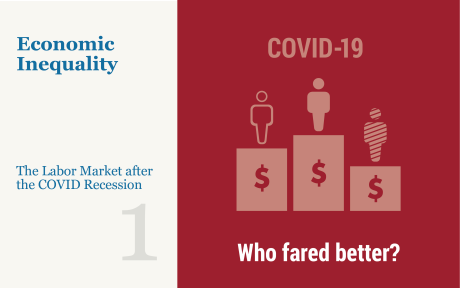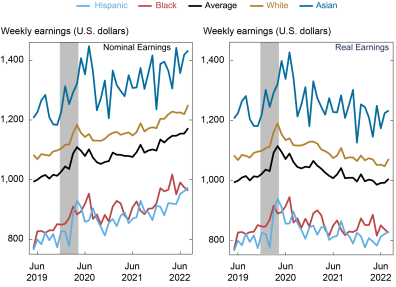
Racial and ethnic earnings disparities have been salient features of the U.S. economy for decades. Between the pandemic-driven recession in 2020 and the rising inflation since 2021, workers’ real and nominal earnings have seen rapid change. To get a sense of how recent economic conditions have affected earnings disparities, we examine real and nominal weekly earnings trends for Asian, Black, Hispanic, and white workers. We find that average real weekly earnings have been declining in the past year, but less so for Black and Hispanic workers than for white and Asian workers. Black and Hispanic workers have also experienced small increases in real earnings since the pre-pandemic period.
Data
We use monthly non-seasonally adjusted data on average weekly earnings for Asian, Black, Hispanic, and white workers age sixteen and older from the Current Population Survey. Weekly earnings can vary because of changes in hourly wages or because of changes in hours worked per week. We obtain similar results for racial and ethnic heterogeneity using hourly wages, so our findings apply directly to the price of labor rather than to changes in hours worked. Since the characteristics of the employed population change with the economy, changes to weekly earnings may reflect both changes in the composition of the employed pool as well as changes in the price of particular skills. We deflate nominal earnings by our demographic-specific inflation measures from a previous post, although our results are similar if we deflate them using the CPI.
Racial and Ethnic Disparities
Trends in nominal and real weekly earnings for the overall average as well as for Asian, Black, Hispanic, and white workers from June 2019 to September 2022 are presented in the chart panels below. We see that there are large and persistent gaps between the earnings (both nominal and real) of white and Asian workers and those of Black and Hispanic workers. Black and Hispanic workers earn about 20 percent less per week than the national average, with Black workers earning slightly more than Hispanic workers. On the other hand, Asian and white workers earn about 20 percent and 7 percent more, respectively, than the national average.
Real Earnings of Black and Hispanic Workers Relatively Resilient

Note: Shaded areas indicate a period designated a recession by the National Bureau of Economic Research.
Nominal earnings for all four groups have increased steadily since
2019 (left panel of the chart), with a pronounced spike at the onset of COVID-19, which reflects that lower-earning individuals were more likely to exit employment during the pandemic recession than higher-earning individuals were. However, much of the growth of nominal earnings since 2021 reflects the rise in inflation. In the right panel, we see that real earnings, adjusted for demographic-specific inflation computed following Avtar, Chakrabarti, and Pinkovskiy (2022), moved similarly to nominal earnings before 2021, including the spike during the pandemic recession, during which inflation was not a factor. In contrast, as inflation rose in the spring of 2021, real earnings started to decline. In particular, they were noticeably lower for the national average in September 2022 ($1,005) than they were in September 2021 ($1,041), soon after the rollout of the first COVID-19 vaccine, or in September 2020 ($1,061), after the end of the lockdowns, or even in September 2019 ($1,015), before the pandemic.
However, the decrease in real earnings has been smaller—over the past year as well as relative to the pre-pandemic period—for Black and Hispanic workers than it has been for white and Asian workers. Average real earnings over the third quarter of 2022 have declined by nearly 3 percent for white and Asian workers relative to the third quarter of 2021. In contrast, average real earnings for Black and Hispanic workers have declined by around 1.6 percent and 1 percent, respectively, over this date range. In fact, over the course of the first five months of 2022, Black workers experienced a sustained increase in real weekly earnings, which then was followed by a sharp reversal in June 2022. Notably, real earnings rose for Black and Hispanic workers between September 2019 and September 2022, while they fell (by 1 to 4 percent, respectively) for white and Asian workers. The relative resilience of Black and Hispanic average weekly earnings, in spite of the higher inflation these groups have experienced, is consistent with the strengthening labor market for these workers over the course of the post-pandemic period as well as the broader recovery after the Great Recession.
Conclusion
We find that, over the past year, nominal earnings of all demographic groups have increased, with sharper increases seen for Black and Hispanic workers. Factoring in differences in inflationary patterns, we find that Black and Hispanic workers’ real earnings have declined less than those of white and Asian workers due to the former two groups’ strong nominal earnings gains, even though Black and Hispanic workers experienced higher inflation than the national average. While average real earnings, and real earnings of white and Asian workers, have decreased since the pre-pandemic period, the real earnings of Black and Hispanic workers posted a small increase over the past three years. We will be monitoring real earnings disparities to see if these trends persist into the last quarter of 2022.

Rajashri Chakrabarti is the head of Equitable Growth Studies in the Federal Reserve Bank of New York’s Research and Statistics Group.

Kasey Chatterji-Len is a research analyst in the Federal Reserve Bank of New York’s Research and Statistics Group.

Daniel Garcia is a research analyst in the Federal Reserve Bank of New York’s Research and Statistics Group.

Maxim Pinkovskiy is an economic research advisor in Equitable Growth Studies in the Federal Reserve Bank of New York’s Research and Statistics Group.
How to cite this post:
Rajashri Chakrabarti, Kasey Chatterji-Len, Daniel Garcia, and Maxim Pinkovskiy, “How Have Racial and Ethnic Earnings Gaps Changed after COVID‑19?,” Federal Reserve Bank of New York Liberty Street Economics, October 20, 2022, https://libertystreeteconomics.newyorkfed.org/2022/10/how-have-racial-and-ethnic-earnings-gaps-changed-after-covid-19/.
Disclaimer
The views expressed in this post are those of the author(s) and do not necessarily reflect the position of the Federal Reserve Bank of New York or the Federal Reserve System. Any errors or omissions are the responsibility of the author(s).














 RSS Feed
RSS Feed Follow Liberty Street Economics
Follow Liberty Street Economics